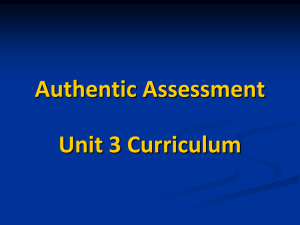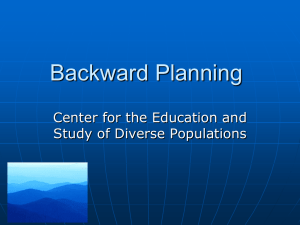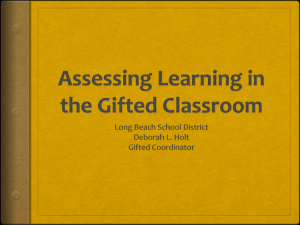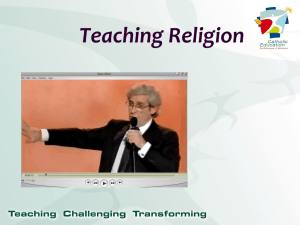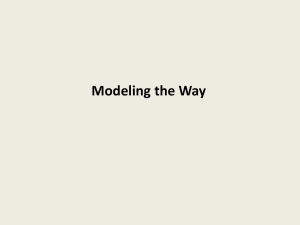What are authentic materials?
advertisement
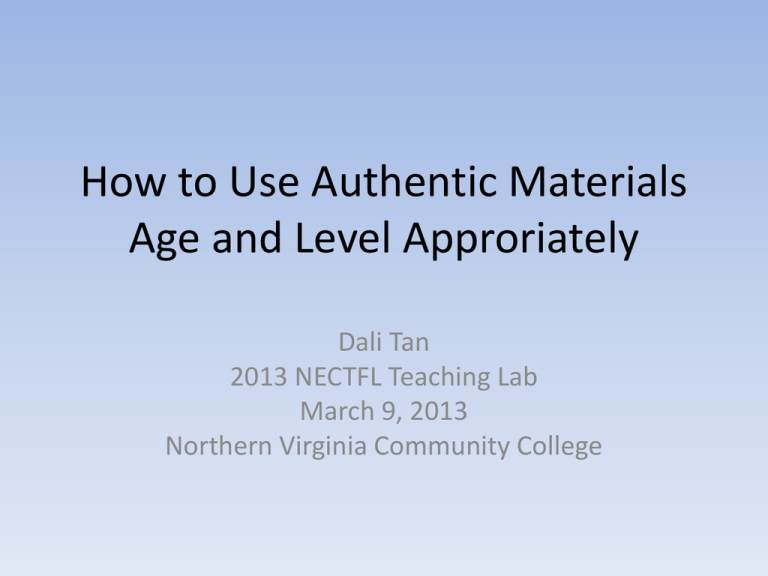
How to Use Authentic Materials Age and Level Approriately Dali Tan 2013 NECTFL Teaching Lab March 9, 2013 Northern Virginia Community College • How to find age and level approriate authentic materials • How to Create age and level appropriate activities using those authentic materials Integration of language and culture: As students learn vocabulary, they see and discuss culturally authentic visuals/realia so that they acquire both language and cultural concepts. For example, in a lesson on housing, students look at photos of various types of housing from the target cultures, name features of each building type, and compare and contrast the housing types with each other and with housing from their own culture. Use of authentic documents: Students discover information dealing with practices and products by analyzing authentic documents, such as movie listings, restaurant ads, bus/subway schedules, invitations, and so on. … For example, students might read a school calenada from a Chinese-speaking country and discuss why its semesters are organized differently. Investigation of cultural truths: students communicate with target language counterparts via e-mail; gather information about their daily routines, school, and interests; and compare these data to their own responses. Definition: What are the authentic materials? How about teacher-created materials? “Authentic texts= “those written and oral communications produced by members of a language and culture group for members of the same language and culture group” p. 74 What are authentic materials? • Authentic materials are resources that have been developed specifically for native speakers. These include print, audio, and visual materials. Examples of Authentic Materials • transportation schedules • pictures of road signs • business cards • labels • menus • brochures • receipts • currency • Tickets • Others • • • • • • • • songs proverbs folktales newspapers televisions programs radio broadcasts film internet websites “Realia (cultural products) are real items of objects from the target culture, such as menus, train tickets, newspaper articles, party invitations, eating utensils, and toys” (p. 153) Why and When to integrate authentic texts? “It has been well documented that students who listen to authentic oral segments , such as radio broadcasts, demonstrate significantly great listening comprehension than do students who do not interact with authentic segments …. Using Authentic Materials Across All Levels • Authentic materials can be used at the beginning level. • How can one find age and level appropriate as well as culturally-rich authentic materials? • The use of authentic material leads naturally to authentic assessments. Several recent studies have examined the effect of introducing authentic readings early in language study (in German and French first semester course, dali’s note). In fact, Maxim (2002) suggests that allowing time for extensive reading on a regular basis may contribute to the development of grammatical and communicative competence, and Gascoign (2002a) encourages teachers to incorporate authentic reading into the L2 classroom from the very first weeks of instruction. These and other studies confirm the advantage of presenting unedited, authentic texts to students as early as possible in language study. (170). … Crucial points to remember in using authentic texts: “Text (i.e., discourse in many forms) will be easier to reproduce, understand, and recall to the extent that it is motivated and structured episodically” p. 73 “Edit the task, not the text” as instructional guideline for teachers as they design activities around an authentic text. P. 77 “Teachers should remember to edit the task to the level of students’ interpretive abilities.” (p. 167) “Choose authentic texts that are age- and level- appropriate, and edit the task, not the text. (p.171) Using Authentic Materials Across All Levels • Authentic materials can be used at the beginning level. • How can one find age and level appropriate as well as culturally-rich authentic materials? • The use of authentic material leads naturally to authentic assessments. 一二三四五, 金木水火土。 天地分上下, 日月照今古。 数字歌 一二三, 爬上山。 四五六, 手拉手。 七八九, 拍皮球。 伸出两只手,十个手指头。 山 村 (宋)劭雍 ____去_______里 烟村_________家 亭台_________座 ___________枝花 http://zhidao.baidu.com/question/65021290.html 姚明 •姓名:姚明(Yao Ming) • 生日:1980.9.12 • 身高:2.26米(NBA官方身高为2.29米) • 体重:141kg • 国籍:中国 • 出生地:上海 • 祖籍:江苏震泽 • 民族:汉族 • 曾效力球队:CBA 上海东方大鲨鱼 • 现效力球队:NBA 休斯顿火箭(现任主教练: 阿德尔曼) • 位置:中锋 •百米速度:15秒左右 • 手掌:21CM • 臂长:225CM • 血型:A型 • 星座:处女座 • 属相:猴 • 喜欢的颜色:蓝色 • 喜欢的动物:都伯文狗 • 喜欢的食物:肉肠、西红柿 • 喜欢的菜系:妈妈的菜 • 喜欢的节日:国庆节 •崇拜的人物:周恩来,刘备,奥特曼 • 欣赏的偶像:萨博尼斯、奥拉朱旺 • 喜欢的作家:叶永烈,老舍 • 喜欢的演员:成龙,李连杰 • 喜欢的影星:丹泽尔.华盛顿 • 喜欢的电影:《虎口脱险》 《奥特 曼》 • 喜欢的地方:纳美克星 • 喜欢的国家:中国 喜欢的服装:运动,休闲 • 休闲地方: 星巴克咖啡屋 • 在休斯敦火箭队时球衣号:11号 • 业余爱好:打电脑游戏(如WOW)、上网 冲浪、音乐、看书 • 绰号:小巨人 • 外国人一般称其:明王朝、移动长城 • 家庭成员; 父亲:姚志源 • 母亲:方凤娣 • 配偶:叶莉 • 林树豪 http://zhidao.baidu.com/question/167592968.html 林书豪会说中文吗? How to introduce the concept and practice of “Xiao” (filial piety) in Chinese culture? The purpose of the following examples from Dali Tan is to “抛砖引玉” ( To throw out a brick in order to bring forth a jade). 中國文化傳統中的“孝” 小鳥 小鳥小﹐老鳥老﹐ 小鳥本是老鳥抱﹐ 小鳥﹐小鳥﹐你今長大了﹐ 老鳥誰養他的老﹖ (This children’s rhyme can be taught in Chinese I ) http://v.ku6.com/show/VwUxpEmnQdFXVmw62T A0kw...html 一封家书 李春波 亲爱的爸爸妈妈: 你们好吗 现在工作很忙吧 身体好吧 我现在广州挺好的 爸爸妈妈不要太牵挂 虽然我很少写信 其实我很想家 爸爸每天都上班吗 管得不严就不要去了 干了一辈子革命工作 也该歇歇了 •我买了一件毛衣给妈妈 •别舍不得,穿上吧 •以前儿子不太听话 •现在懂事他长大了 •哥哥姐姐常回来吗 •替我问候他们吧 •有什么活儿就让他们干 •自己孩子有什么客气的 •爸爸妈妈多保重身体 •不要让儿子放心不 •下今年春节我一定回家 •好了先写到这吧 •此致敬礼! •此致那个敬礼 •年 月 号 • Use of “常回家看看” Across Levels This popular music video song lends itself really well in teaching the concept and practice of “filial piety” across all levels of proficiency. The possibilities are endless. You can use the provided link to show the video. 常回家看看 找点空闲,找点时间, 领着孩子常回家看看. 带上笑容,带上祝愿, 陪同爱人常回家看看. 妈妈准备了一些唠叨, 爸爸张罗了一桌好菜. 生活的烦恼向妈妈说说, 工作的事情向爸爸谈谈. The lyric for this popular song continues in next slide. 常回家看看 (continued) 常回家看看,回家看看, 哪怕帮妈妈洗洗筷子,刷刷碗, 老人不图儿女为家做多大贡献, 一辈子不容易,就图个平平安安. 常回家看看,回家看看, 哪怕帮爸爸捶捶后背,揉揉肩, 老人不图儿女为家做多大贡献啊, 一辈子总操心,就换个平平安安. http://you.video.sina.com.cn/b/2895959-1263555182.html Use an Authentic Story to Teach Cultural Products, Cultural Practices and Cultural Perspectives 我曾经看过台湾著名的作家林清玄写的一篇散文, 他说一个朋友和他要一幅字,自己挂在书房里。 朋友对他说,你要写非常简单的,让我每天看了 以后就有用的一句话。他想了半天,就写了四个 字,叫“常想一二”。那个朋友不懂,说这是什 么意思啊?林清玄解释说,大家都说这个世上 “不如意事常八九,可与言者无二三”,我们就 算认可这种说法吧,但是起码还有一二如意事啊? 我帮不了你太多,我只可以告诉你就常想那“一 二”吧,想一想那些快乐的事情,去放大快乐的 光芒,抑制心底的不快,这就是我作为一个朋友 能够为你做的最好的事情了。 (p.76,于丹论语心得) st 21 Century Skills: “Creativity/Innovation -Students as creators and innovators respond to new and diverse perspectives. They use language in imaginative and original ways to make useful contributions.” • Demonstrating originality and inventiveness in work • Developing, implementing and communicating new ideas to others • Being open and responsive to new and diverse perspectives • Acting on creative ideas to make a tangible and useful contribution to the domain in which the innovation occurs Example 1: When planning to introduce a familiar story from the target culture, teachers might use the following examples of how to make students use creativity and innovation, such as asking them to give a new ending of the story and many other activities. •Reader’s Theatre—act the story out in front of the class •“Hot Seat”—Group members take turns to be in “the hot seat” (stepping into the shoes of different characters in the story, such as the old man, the elder son, the younger son, well-meaning neighbors) •Create a different ending for the story and share it with the whole class •Digital Story Board—Draw pictures and write captions with speech and thought bubbles for different characters in the story •Find a similar or different story from your own culture that illustrate a similar or different “wisdom of life” and compare and analyze the similarity and differences in both cultural practices and perspectives •Write a story from your own personal experience that illustrates that moral of “ 塞翁失马“ story and share it with the whole class •Example 2: When planning to teach geography of China, teachers might use the following activities (such as a rhyme, a game, etc… in a creative and innovative way) 中国地理歌 一二三,三二一. 我和爷爷坐飞机。 坐上飞机去哪里? 坐上飞机旅游去。 先到首都北京城, 看看咱们的天安门。 再坐火车去天津, 狗不理包子买二斤。 坐飞机,飞东南, 看看上海大世界。 看完了上海去重庆, 重庆是咱的火锅城。 吃火锅,谈中国, 中国地大人口多。 土地九百六十万, 人口十三亿还要多。 游完四个直辖市, 下面再把各省说。 先说东北三个省, 黑龙江吉林和辽宁。 往南进入华北区, 山西河北和内蒙。 东南沿海省区多,说起来就有八九个。 山东江苏浙江省, 福建广西和广东, 香港澳门海南岛, 九个一个也不少。 往西走是云南, 西藏贵州和四川。 再走进入大西北, 新疆位置在边陲。 青海甘肃和陕西, 宁夏回族自治区。 游完大陆一大圈, 还有五省在中间。 河南安徽和江西, 还有湖南与湖北。 祖国大陆说一遍 , 只剩台湾在外边。 台湾回归大一统, 祖国山河一片红。 全国省市三十四, 中国地理我先知。 The class is divided into six groups with each group in charge of one part of the rhyme. The group is responsible to draw a map of the cities and provinces and autonomous regions to a scale (predetermined so when maps from all the groups put together, there is a whole map of China), to teach to the rest of the class basic facts, some unique features about their part of the geographic areas (such as topography, historical and sight- seeing landmarks, famous historical figures, famous dishes, and so on). Each group needs to design and produce a 20 minute TV program with a TV commercial/public service announcement about their area as well as a cooking show that teacher the rest of class how to cook a famous dish from that area and a local history program. After each group’s presentation, each group is responsible to provide three things from their area into a time capsule and write out their detailed descriptions of the three things/persons and submit them to the teacher beforehand. The rest of the groups (with each group and each member of the group takes turns) play 20 questions by asking the group questions and try to find out what each item in the time capsule is (only Yes or No questions allowed). The group that has asked the fewest questions before getting the correct answer wins. The culminating activity of the unit is a group Jeopardy Game Show created out of 60 key questions in writing about their area that each group come up with there. The teacher will work with each group to make sure that their writings and facts are accurate before the show in finally assembled in the electronic game board. Reflection: Cultural Products: (both are authentic materials) _a:Familiar story___ ______________________________________ _b: _Chinese Geography_Rhyme________________ Cultural Practices: __a: 不大喜大悲, 不走极端___________ ______________________________________ __b:regional cookings_____________ Cultural Perspectives: __a:__中庸之道,相信物极必反_______ ______________________________________ __b:_how regional cuisines shows concept of balance and healthy living •What kind of discussions you would encourage students to have in order to deepen and expand the cultural comparison that the students have shared with each other? •What follow up tasks you would design so that students are further encouraged to become “creators and innovators” who “respond to new and diverse perspectives” so that “They use language in imaginative and original ways to make useful contributions”? How would you spiral these simple examples up and down to meet the need of your students at various levels of proficiency? Questions? Many thanks for joining us today! dtan@nvcc.edu

